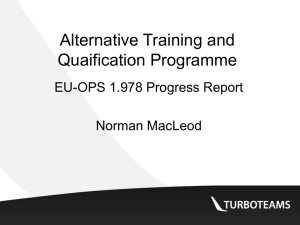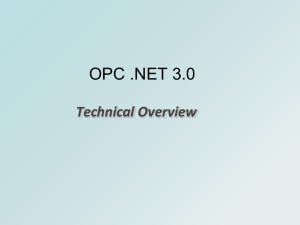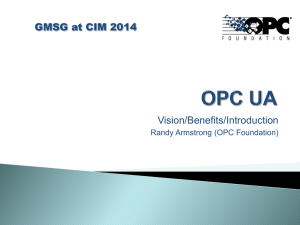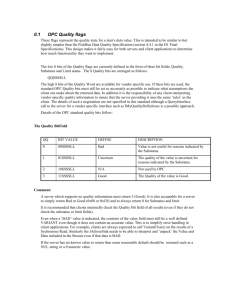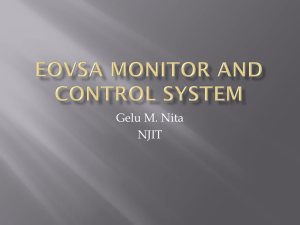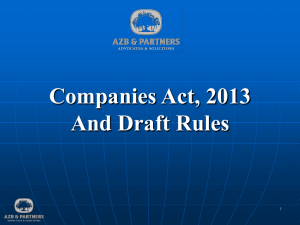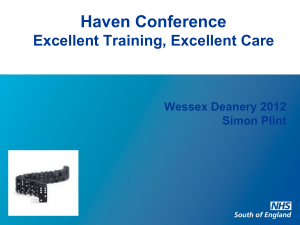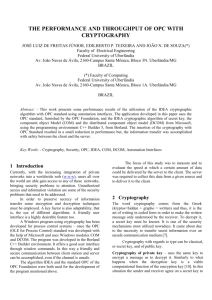Evaluating Impact of Security on OPC UA Performance Salvatore
advertisement
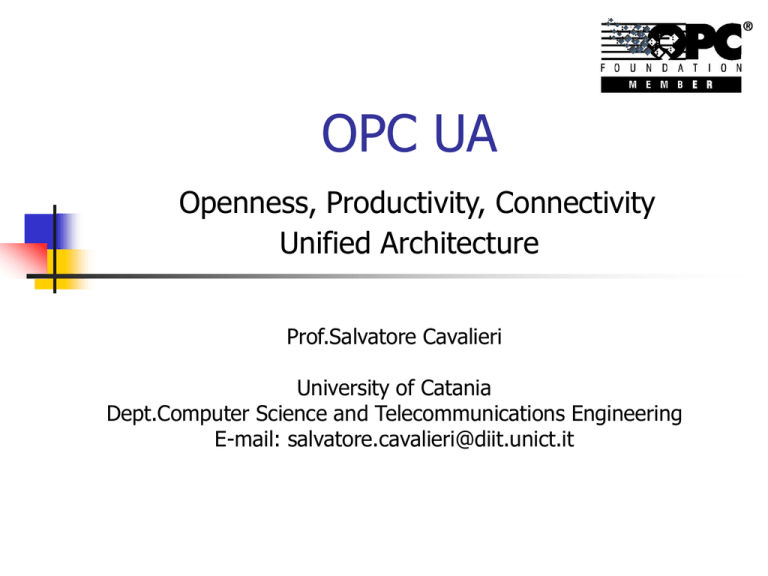
OPC UA Openness, Productivity, Connectivity Unified Architecture Prof.Salvatore Cavalieri University of Catania Dept.Computer Science and Telecommunications Engineering E-mail: salvatore.cavalieri@diit.unict.it OPC UA Specification Definition of OPC specifications started ten years ago to simplify and to standardise data exchange between software applications in industry Microsoft's DCOM has been chosen as the technological basis for the first OPC specifications. When XML and Web Services technologies have been available, the OPC Foundation adopted them as an opportunity to eliminate the shortcomings of DCOM OPC XML Data Access (DA) specification Today, the OPC Foundation has introduced the OPC UA standard which is based on a service-oriented approach. Easy possibilities of: using OPC components on non-Windows platforms, embedding them in devices implementing a standardised OPC communication across firewall boundaries OPC UA Specification Nowadays OPC UA plays a very dominant role in industrial applications SCADA, PLC/PC-based controls and MES systems are unthinkable today without an OPC UA interface. OPC UA Specifications Client Client API Encoding Secure Channel Transport UA Stack UA UA Stack OPC UA Specification Server UA API Server API=Application Process Interface, isolates Client/Server code from OPC UA Stack UA Stack converts API Calls into Messages UA Stack receives Messages delivering them to client or server through the API UA Stack Mappings Enconding UA Stack Security Transport UA Client UA Server Client API Server API UA Binary, UA XML,……. UA Secure Conversation, WS-Secure Conversation, ……. UA TCP, SOAP/HTTP(s), ……. Information Model The set of Objects and related information that the OPC UA Server makes available to Clients is its AddressSpace. The OPC UA AddressSpace is a set of Nodes connected by References. Primitive characteristics of Nodes are described by OPC-defined Attributes. Attributes are the only elements of a Server that have data values. To promote interoperability of Clients and Servers, the OPC UA AddressSpace is structured hierarchically with the top levels the same for all Servers. Although Nodes in the AddressSpace are typically accessible via the hierarchy, they may have References to each other, allowing the AddressSpace to represent an interrelated network of Nodes. OPC UA Servers may subset the AddressSpace into Views to simplify Client access. Information Model Sessions OPC UA requires a stateful model. The state information is maintained inside an application Session. Examples of state-information are: Subscriptions, user credentials continuation points for operations that span multiple requests. Sessions are defined as logical connections between Clients and Servers. Each Session is independent of the underlying communications protocols. Failures of these protocols do not automatically cause the Session to terminate. Sessions terminate based on Client or Server request, or based on inactivity of the Client. The inactivity time interval is negotiated during Session establishment. Security Model OPC UA security is realised through a Secure Channel When an application Session is established, the Client and Server applications exchange software Certificates that identify the Client and Server and the capabilities that they provide. A Secure Channel secures data exchanged in a session in several ways: it maintains the integrity by applying digital signatures it maintains confidentiality by encrypting sensitive information of the transmitted messages. Services OPC UA Services are methods used by OPC UA Client to access the data of the Information Model provided by the Server Services are independent of the transport protocol and the programming environment Only security services depends on the communication protocols used Services OPC UA Services are divided into Service Sets, each defining a logical grouping of Services used to access a particular aspect of the Server. A Profile defines: the Service Sets a Server supports specific Services within a Service Set a Server supports. Services Discovery Service Set This Service Set defines Services used to discover OPC UA Servers that are available in a system. It also provides a manner in which clients can read the network protocol and security configuration required for connection to the Server. The Discovery Services are implemented by dedicated Discovery Servers. Well known dedicated Discovery Servers provide a way for clients to discover all registered OPC UA Services Discovery Service Set UA Client Find Servers Discovery Server UA Server Register Servers Get Endpoints ServerCertificate, SecurityPolice, Encryption, Signature, Authentication, NetworkProtocol Services Discovery Service Set Endpoint: Endpoint Url: network address used by client to establish a secure channel Server Certificate: public key of the Server, used by Client to secure messages exchanged with server Security Policy: algorithm sets and key length to secure channel Security Mode: Signature and/or Encryption, none Authentication: username/password, certificate, anonymous Transport Protocol Services SecureChannel Service Set A SecureChannel is a long-running logical connection between a single Client and a single Server. This channel maintains a set of keys that are known only to the Client and Server and that are used to authenticate and encrypt Messages sent across the network. First, the SecureChannel Services are used to establish a SecureChannel between Communication Stacks allowing to exchange Messages in a secure way. Second, the UA applications use the Session Service Set to establish an UA Application Session. Services Services SecureChannel Service Set This Service Set defines Services used to open a secure communication channel that ensures the confidentiality and integrity of all Messages exchanged. The SecureChannel Services are provided by the communication stack that the UA application is built on. For example, a UA Server may be built on a SOAP stack that allows applications to establish a SecureChannel using the WS-SecureConversation specification. In these cases, the UA application simply needs to verify that a WS-SecureConversation is active whenever it receives a Message. Services SecureChannel Service Set Stack API input parameters: Endopoint Url Security Policy Security Mode Server Certificate Client Certificate Client Private Key Requested Lifetime: The security token must be renewed by the UA Stack before lifetime expires. Services Session Service Set This Service Set defines Services used to establish an application-layer connection in the context of a Session on behalf of a specific user. Create Session Activate Session Close Session Services Read and Write Data and Metadata The simplest way to exchange data between OPC UA Client and Server is based on Read and Write Service Set the Read and Write Services are optimised for bulk read/write operations and not for reading/writing single values. They allow to read/write value of Attributes of Nodes and read/write Attributes (accessing metadata in the Address Space) Services Read Service MaxAge. In ms; if 0, it forces the server to give the current value Type of Timestamps. Source and Server List of Nodes and Attributes to read NodeId AttributeId DataEncoding:client specifies the encoding rule to transport the value. Default: XML, UA binary Services Write Service List of Nodes, Attribute and Value NodeId AtrributeId Value to write Source Timestamp. Null if not set Server Timestamp. Null if not set Services Subscription A different way to access data is the subscription for data changes and/or events. This is the preferred method for clients needing cyclic updates of variable value changes. • Data changes of Variables Values Monitored Item N 1 Subscription N 1 Session •Aggregated Values •Events Subscription Sampling Intervals Monitored Item queues Data changes Variable Value subscription Aggregates Variable Value Object Event Notifier Publish Interval Notifications to OPC UA Client Subscription UA Server UA Client Session Publish Request Publish Queue Publish Response Notifications Subscription Subscription Publish Request is not linked to a specific Subscription It Contains a list of Acknowledgments by Client: SubscriptionId Sequence Number of received notification message to acknowledge Subscription Publish Response contains: SubscriptionId List of Sequence Number of notifications linked to the Subscription and not acknowledged by Client Notification Message Sequence Number PublishTime (Time of the transmission to client) NotificationData (DataChange, Aggregation or Events) Subscription RePublish Request contains: SubscriptionId Retransmit Sequence Number of notification to be resend Subscription Settings: Publishing Interval Max Keep-Alive count: how many Publish Intervals without having notifications to be sent to client, before Server sends a live message (with no notifications) Lifetime count: how many Publish Interval without having connection to client to deliver data. After this interval, subscription is cleared Maximum number of Notifications per Publish (limit the size of notification message) Subscription Monitored Item-Data Changes Monitored Item settings NodeID, AttributeID to be monitored SamplingInterval (ms) QueueSize Filter: Trigger (status, value/status, source timestamp/value/status) Deadband (Absolute, Percent) Subscription Monitored Item-Aggregate Monitored Item settings NodeID, AttributeID to be monitored SamplingInterval (ms), rate at which aggregate are calculated QueueSize Filter: AggregateType (interpolative, average, min, max, etc.)status, value/status, source timestamp/value/status) RawData Rate, rate at which values are sampled from the underlining system to be used to compute aggregate Subscription Monitored Item-Events Monitored Item settings NodeID, AttributeID to be monitored Filter: Select Clauses: List of Events field to return for each notification WhereClause: Definition of the Content Filter events. Es. (EventType=MyEventType) AND (Severity>500) Services Access History of Data and Events HystoryRead Service This service is used to read historical Values or Events of one or more Nodes in an order sequence for the defined time domain Continuation points are used to continue to read of the ordered sequence if not all data can be returned in one HystoryRead response HystoryUpdate Service This service is used to insert, replace, update or delete historical Values or Events Services Access History of Data and Events HystoryRead Service. Different type of read operations on a list of Nodes: Raw Data: StartTime, EndTime Process Data: aggregated based on the raw data in the history database: StartTime, EndTime, ResampleInterval, AggregateType Data at a Series of Timestamp: list of requested timestamps Historical Events: StartTime, EndTime, Filter Application Architecture Software layers to be developed: Client/Server Applications (Application) Higher level functions: e.g. managing connections, processing Service messages (SDK) Lower level functions: e.g. encoding, securing and transmitting messages (Protocol Stack) Application Architecture Stack: Client/Server API, offering methods to configure Stack, sending/receiving OPC UA Services messages, etc. Encoding layer Security layer Transport layer Platform layer, platform-specific code (managing sockets, threads, etc.) Application Architecture SDK Interface to the Application (Client/Server) UA Specific functionality: subscriptions, sessions, events, alarms Common functionality: Security, Configuration, Logging Application Architecture Deliverables by OPC Foundation Stack: ANSI-C, Java (under development), C# .NET Stack in C# Transport layer, security layer, encoding layer HTTP/SOAP, WS-SecureConversation, UA Binary HTTP/SOAP, WS-SecureConversation, XML HTTP/SOAP, WS-SecureConversation, UA Binary and XML UA TCP, UA-SecureConversation, UA Binary Application Architecture Deliverables by OPC Foundation SDK: C++, C# SDK in C# Client library Server library Application Architecture Deliverables by OPC Foundation Sample Client/Server Application in C# Client is a generic OPC UA browser (browse, read, write Node attributes, subscription data events and changes) Server includes Address Space and an example describing a boiler and its componets.
